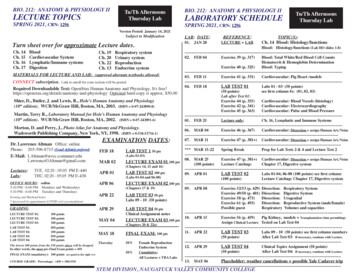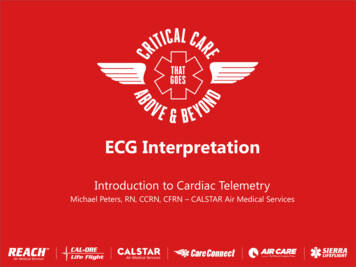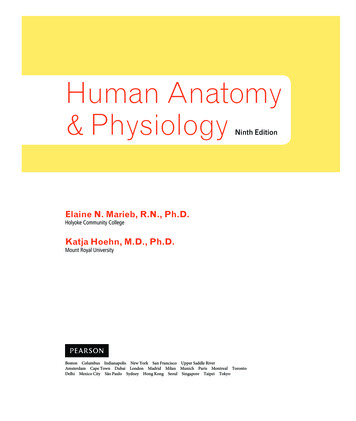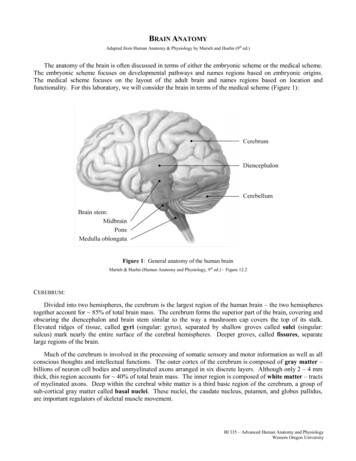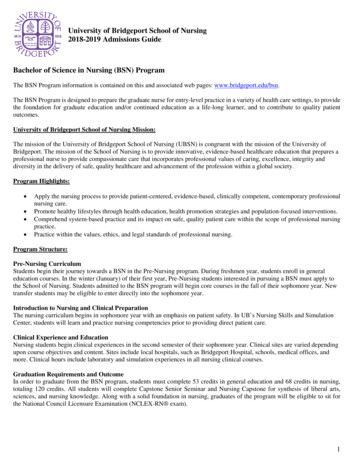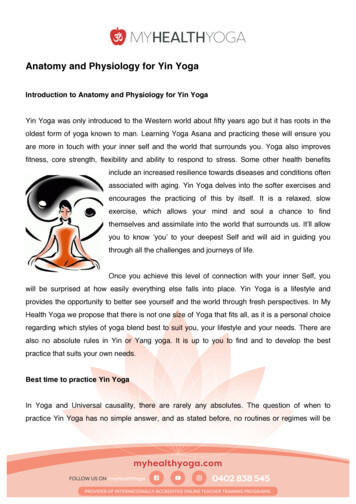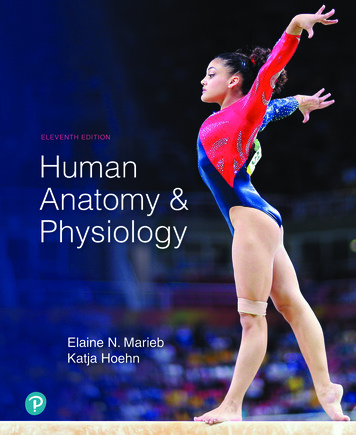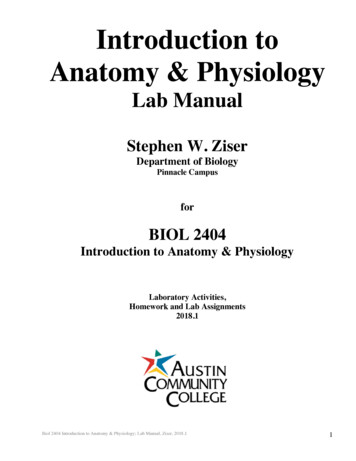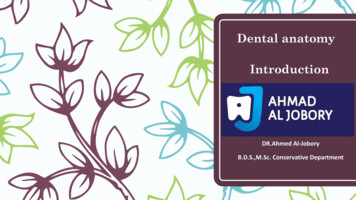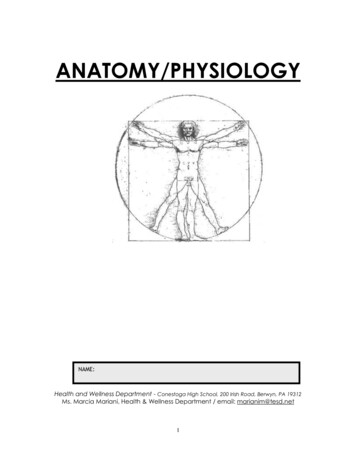
Transcription
ANATOMY/PHYSIOLOGYNAME:Health and Wellness Department - Conestoga High School, 200 Irish Road, Berwyn, PA 19312Ms. Marcia Mariani, Health & Wellness Department / email: marianim@tesd.net1
2
Anatomy/Physiology Course InformationPurposeTo introduce students to the study of gross anatomy and physiology in preparationfor the college-level course(s) required for all students entering the field of HealthSciences.RecommendationIf students are planning a career in a Health Science field, it is stronglyrecommended that they work to achieve a grade of 90% or higher for their transcriptfor college and health science program acceptance.Course Content and Materials Anatomy & Physiology Course Notebook Textbook “Human Anatomy & Physiology” by Elaine Marieb “The Anatomy Coloring Book, 4th Ed” by Wynn Kapit and Lawrence M. Elson.o It is the responsibility of each student to purchase this coloring book. Study Supplies Offered: colored pencils, index cards and composition books.Assessment Students will have an assignment calendar that designates homework for theChapter Review Study Groups will complete a research paper & information presentation onMedical Ethics Students will have Chapter Tests on Chapters 1, 2 and 3. Students will have Chapter and Practical Tests on Chapters 5 and 6. Study Groups will create an electronic research project for their chosen organsystem. Students will have Chapter Packets and Coloring Assignments due at regularintervalso An assignment calendar provided at the start of the course will detailassignments and their respective due dates Group Bonus activities will be provided for extra credit at random intervalsWellness Department Health Sciences AwardBy taking the course, you are automatically eligible for this award. The Conestogasenior who earns the highest overall average in their Health Education andAnatomy/Physiology Courses with intention of pursuing a career in Health Sciencewill win this award. In the case of a tie, the department will then look to grades inother department courses, participation in the Allied Health Program and studentresumes relative to Health Sciences work.3
ANATOMY/PHYSIOLOGYCHAPTER TEST REVIEWSTEST FORMATTEST REMINDERS: YOU WILL HAVE ONE PERIOD TO COMPLETE CHAPTER EXAMS YOU WILL HAVE TWO PERIODS TO COMPLETE PRACTICAL EXAMS CHOOSE THE BEST ANSWER FOR EACH QUESTION SOME QUESTIONS WILL REQUIRE MORE THAN ONE BEST ANSWER – YOU MUSTHAVE BOTH ANSWERS TO EARN CREDIT FOR THE QUESTIONPLANNED TEST FORMAT: Objective Questions STANDARD MULTIPLE CHOICE STANDARD TWO-COLUMN MATCHING FIVE-CHOICE MATCHING CHOOSE THE BEST OF TWO (DIRECTIONAL TERMS) REVERSE DEFINITIONS (definition provided, name the system)PLANNED TEST CONTENT: EACH EXAM WILL CONTAIN CONTENT FROM THE FOLLOWING: CHAPTERCONTENT, CHAPTER PACKET EACH EXAM MAY CONTAIN PREVIOUSLY LEARNED INFORMATION (i.e. motionsmay be on both the Chapter 1 and Chapter 2 tests) SINCE LEARNING IS TO BECUMULATIVE LABELING OF ANATOMICAL TERMS DEFINING ANATOMICAL TERMS APPLICATION OF ANATOMICAL TERMS TO BODY MOVEMENT AND PROCESSES APPLICATION OF ANATOMICAL TERMS TO REAL LIFEPLANNED GRADING: EXAMPLE: A CHAPTER TEST WITH 50 OBJECTIVE QUESTIONS AND 20 MOTIONSQUESTIONS MAY TOTAL AS FOLLOWS:o 1 POINT PER ANSWER POSSIBLE 50 POINTSo 8 QUESTIONS HAVE 2 POSSIBLE ANSWERS 58 POINTSo 3 QUESTIONS HAVE 3 POSSIBLE ANSWERS 62 POINTS TOTAL FOR CHAPTESTo MOTIONS SECTION OF TEST: 20 POINTS TOTAL POINTS POSSIBLE ON TEST 82 POINTSNOTES/REMINDERS:4
CCOONNEESSTTOOGGAA HHIIGGHH SSCCHHOOOOLL WWEELLLLNNEESSSS//FFIITTNNEESSSS DDEEPPAARRTTMMEENNTTAANNAATTOOMMYY PPHHYYSSIIOOLLOOGGYY CCLLAASSSSMedical Ethics Group ProjectDue Date: September 12, 2014Group Names:Directions: Using one of the topics brainstormed in class or a new topic you’re your teacher’sapproval, compose a paper in 5-8 pages that answers the questions below with as much detail aspossible. Remember to be succinct and site sources where necessary.Brainstormed Topics: Euthanasia, Stem Cells, Animal Testing, Abortion, Technology & Healthcare,Genetic Testing, FDA Drug Approvals, Public Health Care Inequities, Public Health Care Costs,Taxing Foods That Contribute to Obesity, Cryogenics, Extraordinary Measures (Life Support),Fetal Testing, Genetic Manipulation, Organ Donation, Genetic Modification of Foods, CloningItem 1: As a group, define medical ethics and explain why is it important to the HealthScience field as a whole?Item 2: As a group, explain to the reader the controversies that exist with respect toyour topic – be sure to equally explain both sides.Item 3: As a group, write a thesis statement for your chosen topic. (Remember, youmay not all agree but there is only one thesis statement for this project).Item 4: As a group, compose a body of content that describes the benefits of thisissue to health care and/or patients.Item 5: As a group, compose a body of content that describes the concerns and/orpotential hazards of this issue to health care and/or patients.Item 6: Write your group conclusion and be sure to refer back to your thesisstatement.Individual Assignment: Obtain a 5x7 card from your classroom teacher and discuss the followingfrom your personal point of view:1234Was there another topic you wanted the group to focus on? Which one? Why?Did you agree with your group’s thesis statement? Why or Why not?What did you find difficult about working with your group on this project?When you step outside your personal feelings about the assignment content,what is the value of this assignment to you as a future medical professional?5
Grading RubricItem 1: As a group, define medical ethics and explain why is it important to the HealthScience field as a whole? Accuracy Succinct Completion Balance/Bias RelevanceItem 2: As a group, explain to the reader the controversies that exist with respect to yourtopic – be sure to equally explain both sides. Accuracy Succinct Completion Balance/Bias RelevanceItem 3: As a group, write a thesis statement for your chosen topic. Remember, you may notall agree but there is only one thesis statement for this project. Accuracy Succinct Completion Balance/Bias RelevanceItem 4: As a group, compose a body of content that describes the benefits of this issue tohealth care and/or patients. Accuracy Succinct Completion Balance/Bias RelevanceItem 5: As a group, compose a body of content that describes the concerns and/or potentialhazards of this issue to health care and/or patients. Accuracy Succinct Completion Balance/Bias RelevanceItem 6: Write your group conclusion and be sure to refer back to your thesis statement. Accuracy Succinct Completion Balance/Bias Relevance6
Human Anatomy/Physiology Group Research ProjectPurpose: To introduce your chosen body system to your classmates by explaining why it is importantand amazing!To educate your classmates on the gross anatomy, physiology and basic functions/purposeof your chosen body system.To demonstrate how the individual parts of your chosen system combine to function.To explain how those functions serve the body as a whole – specifically how it may partnerwith other systems.To demonstrate and provide examples of at least two conditions which may result if thesystem fails to function as expected.To test your classmates’ knowledge of your chosen body system.Research: Gather background information on the components of your body system and their functionsusing at least five reliable health science resources. You should rely primarily on .gov; .edu;and some .org websites. You should also use reference books and professionaljournals/magazines. You should avoid Wikipedia and organizations that may have a biasviewpoint or are trying to make money from selling a product or philosophy.Create a basic outline of the content you feel would best achieve your project purpose.Find two graphics that would support your content.Find at least two online video or visual clips that you can insert as hyperlinks in your project tofurther explain structure and function to your classmates.Create Your Electronic Project: Cover Page that includes your name and grade.A minimum of five pages of written text that fulfill the purpose of the project.Your hyperlinks/reference links should be included throughout the project to support/explainthe written content.Bibliography of all materials/resources/research and reference links used to create yourproject.Create the evaluation tool your peers will complete.Create an electronic answer key for your teacher.Peer Evaluation Tool: Create a 20 question worksheet or quiz for your classmates to print and complete.Please use questions that are purposeful rather than just creating ‘busy work’ questionnaires!Be sure all answers are available via the written text and/or the links in your project.Be sure answers would have only one best answer.Submit Your Project: Project Due Date: Friday, December 12, 2014 no later than 11:59:59pmProject should be submitted electronically to your project folder on SynergyEmail the electronic answer key ONLY to Ms. Mariani (honor system!).Be sure to submit the hard copy of the grading form attached to this page.Our TopicNotes:7
ANATOMY-PHYSIOLOGY ORGAN SYSTEM RESEARCH PROJECTGRADING RUBRICGROUP NAMESAPPROVED TOPIC (YES/NO) – FAILURE TO USE APPROVED TOPIC WILL RESULT IN ZERO GRADEPROJECT SUBMITTED BY DEADLINE (10) NOTE: ADDITIONAL 5-POINT DEDUCTION PER 12 HOURS LATEINTRODUCTION (10)REQUIRED WRITTEN CONTENT LENGTH OF 5 PAGES WITHOUT GRAPHICS (20) ALL PARTS OF SYSTEM DISCUSSED ACCURATE AND CONCISE INFORMATIONMINIMUM OF 2 REQUIRED GRAPHICS - 1 PAGE OF CONTENT (10) CLEAR REPRESENTATION OF WRITTEN CONTENT GRAPHICS SERVE TO FURTHER EDUCATE PEERSCLARITY/PURPOSE/EDUCATIONAL VALUE OF SUPPORTING WEB VISUAL # 1 (10)CLARITY/PURPOSE/EDUCATIONAL VALUE OF SUPPORTING WEB VISUAL #2 (10)GROSS ANATOMY CONTENT (20) PARTS FUNCTION RELATIONSHIP TO BODY AS A WHOLEPHYSIOLOGY CONTENT (20) PARTS FUNCTION RELATIONSHIP TO BODY AS A WHOLEORIGINALITY/CREATIVITY OF CONTENT (10)DISEASE/CONDITION # 1 (10)DISEASE/CONDITION # 2 (10)BIBLIOGRAPHY (20) MINIMUM OF 5 SOURCES OBTAINED AND USED RELIABILITY OF HEALTH SCIENCE SOURCES MOST CURRENT INFORMATION AVAILABLE UNLESS USED FOR HISTORICAL REFERENCE PROPER USE OF MLA FORMATTING20-QUESTION TEST OF PEER KNOWLEDGE (REVIEW WORKSHEET) (20) PURPOSEFUL QUESTIONS CLARITY OF QUESTIONS FORMAT OF QUESTIONSOVERALL TOPIC COVERAGE, QUALITY AND CLARITY (20)TOTAL POINTS EARNED OF 2008
CHAPTER 1THE HUMAN BODYAN ORIENTATION9
10
Chapter 1 ObjectivesMost of us are naturally curious about our bodies; we want to knowwhat makes us tick. This curiosity is even seen in infants, who can keepthemselves happy for a long time staring at their own hands or pullingtheir mother's nose. Older children wonder where food goes whenthey swallow it, and some believe that they will grow a watermelon intheir belly if they swallow the seeds. They scream loudly whenapproached by medical personnel (fearing shots that sting), but theylike to play doctor. Adults become upset when their hearts pound,when they have uncontrollable hot flashes, or when they cannotkeep their weight down. Anatomy and physiology, subdivisions ofbiology, explore many of these topics as they describe how ourbodies are put together and how they work.Objective ChecklistAn Overview of Anatomy and Physiology Define anatomy and physiology. Explain how anatomy and physiology are related.Levels of Structural Organization Name the levels of structural organization that make up thehuman body and explain how they are related. Name the organ systems of the body and briefly state the major functions of eachsystem. Classify by organ system all organs discussed. Identify the organs shown on a diagram or a dissectible torso.Maintaining Life List functions that humans must perform to maintain life. List the survival needs of the human body.Homeostasis Define homeostasis and explain its importance. Define negative feedback and describe its role in maintaining homeostasis andnormal body function.The Language of Anatomy Describe the anatomical position verbally or demonstrate it. Use proper anatomical terminology to describe body directions, surfaces, andbody planes. Locate the major body cavities and list the chief organs in each cavity.Copyright 1995 - 2009, Pearson Education, Inc., publishing as PearsonBenjamin Cummings11
12
Body Planes (see diagram)Plane –Median –Sagittal –Coronal or Frontal –Transverse or Cross Horizontal –Body SectionsSection Sagittal Section Midsagittal Section or Median Section Frontal or Coronal Section Tranverse or Cross Section -LandmarksMeatus – an opening or tunnel through any part of the body – Example:Process – a thin projection or prominence – Example:Projection – (protuberance) – something that juts out – Example:Foramen – a hole or opening – Example:Plate – a flat structure or part – Example:Epicondyle – a projection on a bone, above another part, the condyle – Example:Condyle – a rounded bump on a bone where it forms a joint with another bone or bones –Example:13
Regional Terms: Anterior Body LandmarksAbdominal –Antecubital –Axillary –Brachial –Buccal –Cervical –Digital –Femoral –Inguinal –Oral –Orbital –Patellar –Pubic –Thoracic –Umbilical –Regional Terms: Posterior Body LandmarksDeltoid –Gluteal Lumbar Occipital Popliteal Scapular Sural -14
Anatomical Directions or PositionsAnatomical Position –Cranial/Superior Caudal/Inferior -Anterior/Ventral Posterior/Dorsal -Medial Lateral Intermediate -Proximal Distal -Superficial Deep -Body CavitiesDorsal Cavity Cranial Cavity –Spinal Cavity –Ventral Cavity Superior Thoracic Cavity –Abdominopelvic Cavity –15
Bone MarkingsProjections Where Muscles Attach:Tuberosity –Crest –Trochanter –Line –Tubercle –Epicondyle –Spine –Projections That Form Joints:Head –Facet –Condyle –Ramus –Depressions/Openings for Vessels/Nerves:Meatus –Sinus –Fossa –Groove –Fissure –Foramen –16
Anatomical MotionsFlexion –Inversion –Extension –Eversion –Hyperextension –Dorsiflexion –Rotation –Plantar flexion –Abduction –Retraction –Adduction –Protraction –Circumduction –Elevation –Lateral Flexion –Depression –Lateral/External Rotation –Upward Rotation –Medial/Internal Rotation –Distraction (Traction) –Supination –Compression –Pronation -Opposition –Radial/Ulnar Deviation -17
Muscle AttachmentsOrigin –Insertion –Tendon –Muscle –The Five Golden Rules of Skeletal Muscle Activity1 – All muscles cross at least one joint.2 – Typically, the bulk of the muscle lies proximal to the joint crossed.3 – All muscles have at least two attachments: the origin and the insertion.4 –Muscles can only pull, they never push.5 – During contraction, the muscle insertion moves toward the origin.Types of MusclesPrime Movers –Antagonists –Synergists –Fixators ---------------------------------GROUP CHALLENGE: Answer the following on a separate sheet of paperACTION: Lifting your backpack with your right hand from the floor to your right shoulderCHALLENGE: List each of the above in the order they are used.18
Medical ImagingMEDICAL RADIOGRAPHY:PROJECTIONAL RADIOGRAPHS (X-RAYS)FLUOROSCOPYNUCLEAR MEDICINE:GAMMA CAMERASPET (POSITRON-EMISSION TOMOGRAPHY)TOMOGRAPHY:CT OR CAT SCANS (COMPUTED TOMOGRAPHY or COMPUTED AXIAL TOMOGRAPHY)LINEAR TOMOGRAPHYORTHOPANTOMOGRAPHY (OPT or OPG)POLY TOMOGRAPHYZONOGRAPHYDSR (DYNAMIC SPATIAL RECONSTRUCTION)MEDICAL ULTRASONOGRAPHY or ULTRASOUND IMAGINGMRI (MAGNETIC RESONANCE IMAGING)MPI (MAGNETIC PARTICLE IMAGING) - (FEB. 2009 BY ROYAL PHILIPS ELECTRONICS)ELECTRON MICROSCOPY19
PHOTOACOUSTIC IMAGING IN BIOMEDICINEDIGITAL INFRARED IMAGING THERMOGRAPHYTHREE-DIMENSIONAL ------------Group Bonus OpportunityWhat are 3 new types of medical imaging that are in use or are in the process of beingapproved for use today? Describe each and the stage of use/approval. (Suggestedresearch website(s): www.tedtalks.com; www.nih.gov; www. Fda.gov)20
Anatomy/PhysiologyNamePLANES, ORIENTATION, DIRECTION AND MOTION PRACTICE1As the ballroom dance couple waltzed around the floor, they maintained perfectposture in each other’s2planes.The Frisbee sailed over the players’ head following theplane.3As Lady pranced by Tramp, he “checked her out” fromto4.When Mary accepted John’s proposal, he slipped the engagement ring onto herfinger from the5to theend.Xena, seeing no other option to save the town from ‘a really bad guy’, slid her swordinto the ‘bad guy’ from theaspect of his abdomen to theuntil he collapsed.6To perform access the man’s beating heart, the Cardiothoracic Surgeon made aSection along the sternum to break open the rib cage.7In performing a Mastectomy, the surgeon’s first incision was into theregion of the woman’s body.8So she wouldn’t have a sore arm for softball practice, Theresa opted to have hershot in herregion.9To grasp the handle of the pencil sharpener, Sarah used finger10To perform Jumping Jacks in P.E. class, the students usedandof the legs and arms.21
11To drink the hot chocolate from his mug, John usedof the wristand forearm.12To release the Frisbee from her hand, Clara usedof the wrist to complete a perfect throw.13Look up in the sky it’s a bird it’s a plane it’sof the neck!14When the ballerinaher ankle to rise up onto the verytippy top of her toes, John thought to himself ‘Wow. that must really hurt!”.15Julia was constantlyandher scapula’sin class to the point where other kids never had a chance to raise their hands.MAKE YOUR OWN:16171822
NAME:Wake Up!Directions: Describe the motions you use each morning to get ready for school. Matcheach action with its appropriate motion. You will NOT use all of the motions listed! You willnot use any motion twice!1.2.Getting out of bed both feet are on the floor to stand up you must a.feetb.kneesc.hipsWashing your hair a.Your shoulders mustwhen moving in asuperior directionb.Your shoulders mustwhen moving in aninferior direction.3.4.To put on deodorant a.The wrist of the applying hand mustb.The shoulder of the receiving underarm mustTo put on your jeans a.To lift your leg into your jeans, your hip mustb.To push your foot through the opening at the bottom, your foot throughthe opening at the bottom, your knee must5.andTo put your foot into your shoe a.Your foot must first23
STUDENT ACTIVITIES FOR BETTER LEARNING1ASSUME THE ANATOMICAL POSITION. HOW DOES THIS POSITION DIFFER FROM THE“USUAL” STANDING POSITION? WHY IS KNOWING THIS POSITION IMPORTANT TO YOURCURRENT STUDIES?2REMOVE ALL THE ORGANS FROM PAT RETURN THEM TO THEIR PROPER ANATOMICALLOCATION. AS YOU REPOSITION EACH ORGAN, SAY ITS NAME AND BODY CAVITY. WHATELSE CAN YOU TELL US ABOUT EACH ORGAN?3SHOW HOW A CHAIR WOULD BE CUT ALONG THE SAGITTAL, FRONTAL AND TRANSVERSEPLANCES. WHICH (IF ANY) OF THESE SECTIONS WOULD YIELD A “USEABLE” CHAIR? WHYWOULD THE OTHERS NOT?4WHY DO YOU THINK A DOG INSTINCTIVELY CURLS OVER AND PROTECTS ITS ABDOMENWHEN THAT BODY REGION IS APPROACHED EVEN PLAYFULLY?5TWO PEOPLE HAVE RAPIDLY GROWING TUMORS. THE TUMOR IS IN THE DORSAL CAVITY INONE OF THESE INDIVIDUALS AND IN THE VENTRAL CAVITY IN THE OTHER. WHICH OF THESEPEOPLE WILL DEVELOP SYMPTOMS FIRST AND WHY?6YOUR TEACHER WILL CALL OUT ANATOMICAL TERMS. YOU AND YOUR CLASSMATES MUSTPOINT TO THE NAMED REGIONS OR AREAS ON YOUR OWN BODY.7HOW IS SCRATCHING AN ITCH AN EXAMPLE OF NEGATIVE FEEDBACK?8COMMENT ON THE FUNCTIONAL RELATIONSHIPS BETWEEN MUSCLES AND BONES.9COMMENT ON THE FUNCTIONAL RELATIONSHIPS BETWEEN THE RESPIRATORY ANDCIRCULATORY SYSTEMS.10ACTIVITY ON THE IMPORTANCE OF RELATIVELY CONSTANT CONDITIONS ON OPTIMALFUNCTIONING OF ANY SYSTEM: USE A SIMPLE BATTERY-OPERATED CLOCK AS YOUR SUBJECT. WHAT WOULD HAPPEN IFIT WAS a. immersed in waterb. hit with a hammerc. heated until it was red-hotd. had its battery removed WHAT CONDITIONS WOULD BE BEST SUITED FOR THE CLOCK TO OPERATE? WHATSINGLE TERM DESCRIBES THOSE CONDITIONS?11WHAT IS THE MEANING OF THE WORD “ALIVE”? DEVELOP A LIST OF CHARACTERISTICSASSOCIATED WITH BEING “ALIVE”.12PRINT, PHOTOCOPY OR CUT OUT AN ARTICLE FROM A RELIABLE SOURCE THAT DESCRIBESAN EVENT OR PROBLEM IN THE YEAR 2002-2003 THAT THREATENS HOMEOSTASIS – EVENSURVIVAL. BE PREPARED TO DESCRIBE THE PROBLEM AND HOW IT REPRESENTS A THREATTO THE BODY.13THE MAGNETIC HUMAN PROJECT.24
CHAPTER FIVETHE SKELETON25
26
THE SKELETAL SYSTEMFUN FACTS OF LITTLE INTEREST TO ANYONE BUT ANATOMY GEEKS: Without the skeleton we would collapse literally, we would fall down – no walkingfor us! We would have a great view of the floor nothing but a blob of stuffed skin! How many bones? You were born with over 300 some of those fused together overthe years, so an adult skeleton has 206 bones with some people having less if onewas removed, some more if they were born with an extra appendage or so. Our skeleton stays together because of ligaments that attach many of our bones toeach other. Bones cannot move without the help of muscles. Muscles are attached to bones bytendons. Bones are alive they are made up of many bone cells and have a blood supply.The blood supply brings food (nutrients) and oxygen to the bone and takes thewaste products away. If a bone “dies”, it cannot repair itself and must either be fused to surrounding boneor replaced by an artificial joint or limb.GATHER MORE FUN FACTS OF YOUR OWN!27
CHAPTER 5: THE SKELETAL SYSTEMIBONES: AN OVERVIEWABCIIIIIIVVFUNCTIONS OF THE BONESCLASSIFICATION OF BONESSTRUCTURE OF A LONG BONE1.GROSS ANATOMY2.MICROSCOPIC ANATOMYDBONE FORMATION, GROWTH, AND REMODELINGEBONE FRACTURESAXIAL SKELETONASKULL1.CRANIUMa.Frontal Boneb.Parietal Bonesc.Temporal Bonesd.Occipital Bonee.Spheniod Bonef.Ethmoid Bone2.FACIAL BONESa.Mandibleb.Maxillaec.Palatine Bonesd.Zygomatic Bonese.Lacrimal Bonesf.Nasal Bonesg.Vomer Boneh.Inferior Conchae3.THE HYOID BONE4.FETAL SKULLBVERTEBRAL COLUMN (SPINE)1.CERVICAL VERTEBRAE2.THORACIC VERTEBRAE3.LUMBAR VERTEBRAE4.SACRUM5.COCCYXCBONY THORAX1.STERNUM2.RIBSAPPENDICULAR SKELETONABONES OF THE SHOULDER GIRDLEBBONES OF THE UPPER LIMBS1.Arm2.Forearm3.HandCBONES OF THE PELVIC GIRDLEDBONES OF THE LOWER THROSESCDIARTHROSESDEVELOPMENTAL ASPECTS OF THE SKELETON28
Practice Quiz: Full Anterior/Posterior Skeleton29
30
31
32
33
LEARNING ANATOMY: THOUGHTS TO PONDER, ACTIVITIES TO TRY 1WHAT ARE THE DIFFERENCES BETWEEN THE SKELETONS OF: MALES AND FEMALES,ATHLETES AND SEDENTARY PEOPLE, YOUNG AND THE ELDERLY? HETEROTROPHICBONES AND ACCESSORY BONES MAY BE FOUND IN MANY PEOPLE. WHATINFORMATION CAN SKELETONS PROVIDE IN FORENSIC MEDICINE?2DID YOU KNOW: OSTEOGENIC SARCOMA AND LEUKEMIA ARE COMMON CANCERSIN PEOPLE EXPOSED TO RADIATION BECAUSE OF THE DEPOSITION OF MINERALS INBONE.3BONE IS NOT A STATIC TISSUE RATHER, IT IS VASCULAR AND CONSTANTLY PRODUCEDAND REABSORBED FOR THE PURPOSE OF CALCIUM HOMEOSTASIS AND TO ALLOW ITTO ACCOMMODATE FUNCTIONAL AND GRAVITATIONAL STRESS. MODERATE WEIGHTBEARING EXERCISE WILL STIMULATE BONE FORMATION AND MAY HELP PREVENTDISEASES SUCH AS OSTEOPOROSIS.4OSSIFICATION IS INCOMPLETE AT BIRTH. WHAT IS THE TIMETABLE FOR OSSIFICATION?5WHAT ARE THE RISK FACTORS FOR OSTEOPOROSIS? WHAT ARE SOME CURRENTTREATMENTS? WHAT ARE SOME PROPOSED FUTURE THERAPIES?6DID YOU KNOW THAT YOU CAN STAND ON A CHINA CUP? THIS IS A DEMONSTRATIONOF THE COMPRESSIONAL STRENGTH THAT CALCIUM/BONE SALTS PROVIDE TO BONETISSUE. WHY? CAN YOU USE A LEATHER BELT TO DEMONSTRATE THE TENSILE STRENGTHTHAT COLLAGEN PROVIDES TO BONE TISSUE?7USING SKIPPY, DEMONSTRATE THE MOVEMENTS THAT ARE PERMITTED AT DIARTHROTICJOINTS.8USE SKIPPY AND HIS GRAVEYARD BONES TO LOCATE THE VARIOUS BONES OF THESKELETON.9IDENTIFY THE ROLES OF CALCIUM IN THE BODY (OTHER THAN MAKING BONES HARD)10WHAT ARE THE VARIOUS HORMONAL INFLUENCES ON THE SKELETON? WHAT DRUGSARE CURRENTLY USED TO HELP CORRECT GIGANTISM AND DWARFISM?11WHY ARE INCOMPLETE OR GREENSTICK FRACTURES MORE COMMON IN CHILDRENTHAN IN ADULTS?12CLASSIFY THE BONES OF SKIPPY’S GRAVEYARD AS LONG, SHORT, FLAT OR IRREGULAR.34
SAMPLE BONE LIST1ST INCISORHEAD OF RADIUSPELVIC BRIM (ARCUATE LINE)1ST MOLARHUMERUSPHALANGES2ND INCISORILIAC CRESTPISIFORM2ND PREMOLARILIAC FOSSAPOSTERIOR INFERIOR ILIAC SPINEACETABULUMINFERIOR ANGLEPROXIMAL PHALANXACROMIOCLAVICULAR JOINTINFERIOR PUBIC RAMUSPROXIMAL TIBIOFIBULAR JOINTACROMION PROCESSINFRASPINOUS FOSSAPUBIC SYMPHYSISALVEOLAR MARGINSINTERCONDYLAR EMINENCERADIAL TUBEROSITYANTERIOR BORDER OF TIBIAINTERCOSTAL CARTILAGERADIUSANTERIOR INFERIOR ILIAC SPINEINTERTROCHANTERIC CRESTSACRAL SPINEATLASINTERTUBERCULAR GROOVESACROILIAC JOINTAXILLARY BORDERINTERVERTEBRAL DISKSACRUMAXISIP JOINTSCAPULABASE OF METACARPALISCHIAL SPINESCAPULAR SPINEBODY OF STERNUMLACRIMAL BONESPHENOID BONEBODY OF VERTEBRALAMBDOIDAL SUTURESPINOUS PROCESSCALCANEUSLATERAL CONDYLESQUAMOUS SUTURECANINE TEETHLATERAL EPICONDYLESTYLOID PROCESS OF RADIUSCAPITULUMLATERAL MALLEOLUSSTYLOID PROCESS OF SKULLCARPAL BONESLATERAL PTERYGOID PLATESTYLOID PROCESS OF ULNACERVICAL SPINELESSER TROCHANTERSUPERIOR ANGLECOCCYXLESSER TUBERCLESUPERIOR ARTICULAR PROCESSCORACOID PROCESSLUMBAR SPINESUPERIOR BORDERCORONAL SUTURELUMBAR VERTEBRASUPERIOR PUBIC RAMUSCRANIUMLUNATETALOCRURAL JOINT (ANKLE)CUBOIDMANDIBLETALUSDISTAL PHALANXMANDIBULAR FOSSATARSAL BONESDISTAL TIBIOFIBULAR JOINTMANDIBULAR RAMUSTEMPORAL BONESETHMOID BONEMANUBRIUMTEMPORALMANDIBULAR JOINTEXTERNAL AUDITORY MEATUSMASTOID BONETHORACIC SPINEEXTERNAL OCCIPITAL PROTUBERANCEMAXILLATHORACIC VERTEBRAFALSE PELVISMEDIAL EPICONDYLETIBIAFALSE RIBMEDIAL MALLEOLUSTIBIAL TUBEROSITYFEMURMEDIAL PTERYGOID PLATETRANSVERSE PROCESSFIBULAMETACARPALTRAPEZIUMFLOATING RIBMETATARSALTROCHLEAFORAMEN MAGNUMMIDDLE PHALANXTROCHLEAR NOTCHFRONTAL BONEMP JOINTTRUE PELVISGLABELLANASAL BONETRUE RIBGLENOHUMERAL JOINTNAVICULARULNAGLENOID FOSSANECK OF FEMURVERTEBRAL BORDERGREATER TROCHANTEROBTURATOR FORAMENVERTEBRAL FORAMINAGREATER TUBERCLEOCCIPITAL BONEVOMERGREATER WING OF SPHENOIDOCCIPITAL CONDYLESXIPHOID PROCESSHAMATEOLECRANON PROCESSZYGOMATIC BONEHEAD OF FEMURPALATINE BONEZYGOMATIC PROCESSHEAD OF FIBULAPARIETAL PROCESSLORDOSISHEAD OF HUMERUSPATELLAKYPHOSISHEAD OF METACARPAL35
36
CHAPTER 6MUSCULAR SYSTEM37
CHAPTER 6: THE MUSCULAR SYSTEMIOVERVIEW OF MUSCLE TISSUESABIIIIIIVVMUSCLE FUNCTIONSMUSCLE TYPES1Skeletal muscle2Smooth muscle3Cardiac muscleMUSCLE ACTIVITYASTIMULATION AND CONTRACTION OF SINGLE SKELETAL MUSCLE CELLS1The Nerve Stimulus and Action Potential2Mechanism of Muscle Contraction: The Sliding Filament TheoryBCONTRACTION OF A SKELETAL MUSCLE AS A WHOLE1Graded ResponsesaMuscle Response to Increasingly Rapid StimulationbMuscle Response to Stronger Stimuli2Muscle Fatigue and Oxygen Debt3Types of Muscle Contractions – Isometric, Isotonic, Isokinetic4Muscle Tone5Effect of Exercise on MusclesBODY MOVEMENTS AND NAMING SKELETAL MUSCLESATYPES OF BODY MOVEMENTSBTYPES OF MUSCLESCNAMING SKELETAL MUSCLESGROSS ANATOMY OF SKELETAL MUSCLESAHEAD MUSCLES1FACIAL MUSCLESaFrontalisbOrbicularis OculicOrbicularis OrisdBuccinatoreZygomaticus2CHEWING MUSCLESaMasseterbTemporalisBTRUNK AND NECK MUSCLES1ANTERIOR MUSCLESaSternocleidomastoidbPectoralis MajorcIntercostal MusclesdMuscle of the Abdominal Girdle2POSTERIOR MUSCLESaTrapeziusbLatissimus DorsicDeltoidCMUSCLES OF THE UPPER LIMB1MUSCLES OF THE HUMERUS THAT ACT ON THE FOREARMaBiceps BrachiibTriceps BrachiiDMUSCLES OF LOWER LIMB1MUSCLES CAUSING MOVEMENT AT THE HIP JOINTaIliopsoasbAdductor MusclescGluteus MaximusdGluteus Medius2MUSCLES CAUSING MOVEMENT AT THE KNEE JOINTaSartoriusbQuadriceps GroupcHamstring Group3MUSCLES CAUSING MOVEMENT AT THE ANKLE AND FOOTaTibialis AnteriorbPeroneus MusclescGastrocnemiusDEVELOPMENTAL ASPECTS OF THE MUSCULAR SYSTEM38
MUSCLE PHYSIOLOGY STUDY GUIDE39
I.II.III.THREE TYPES OF MUSCLE TISSUE FOUND IN THE HUMAN BODYA.SMOOTHB.CARDIACC.SKELETALTHE GENERAL CHARACTERISTICS AND PROPERTIES OF EACH ARE:PROPERTIESSMOOTHCARDIACSKELETALFIBER Y SLOWMODERATEVERY QUICKEFFECT OF CUT NERVE FIBERSLIGHTSLIGHTTOTAL PARALYSISSKELETAL MUSCLEA.SKELETAL MUSCLE IS HIGHLY SPECIALIZED TO AND SPECIFICALLY ADAPTED TOCARRY OUT THREE MAJOR FUNCTIONS1.BODY MOTION2.HEAT PRODUCTION (40%-50% OF HEAT PRODUCTION)3.POSTURE AND BODY SUPPORTB.SKELETAL SYSTEM DIVIDED INTO TWO GROUPS1.MUSCLES OF THE AXIAL SKELETON (FACIAL, MASTICATION, NECK, EYE,VERTEBRAE)2.MUSCLES OF THE APPENDICULAR SKELETAL (GIRDLES, APPENDAGES)C.TERMINOLOGY ASSOCIATED WITH MUSCLES1.ORIGIN - STATIONARY ATTACHMENT2.INSERTION - MOVEABLE ATTACHMENT3.TENDON - ATTACH MUSCLE TO BONE4.GASTER - MUSCLE BULK5.APONEUROSIS - SHEETLIKE LAYER OF CONNECTIVE TISSUED.DESCRIPTION OF THE ANATOMY OF SKELETAL MUSCLE1.THE ENTIRE MUSCLE IS WRAPPED IN A SHEATH CALLED THE EPIMYSIUM40
2.3.4.5.6.7.8.9.10.THE PERIMYSIUM SEPARATES THE MUSCLE INTO BUNDLES OR FASCICLESTHE ENDOMYSIUM SEPERATES EACH INDIVIDUAL MUSCLE CELLEACH MUSCLE FIBER (CELL) CONTAINS MYOFIBRILSEACH MYOFIBRIL CONTAINS THE CONTRACTILE PROTEINS MYOSIN ANDACTINEACH MUSCLE FIBER (CELL) IS SURROUNDED BY A PLASMA MEMBRANECALLED THE SARCOLEMMATHE CYTOPLASM OF THE CELL IS CALLED THE SARCOPLASMTHE SARCOPLASMIC RETICULUM IS A NETWORK MEMBRANE ENCLOSEDTUBULES THAT FORM A SLEEVE AROUND EACH MYOFIBRIL (IMPORTANTIN METABOLIC FUNCTION)THE T-TUBULES RUN TRANSVERSE THROUGH THE MUSCLE FIBER AND AREINTERNAL EXTENSIONS OF THE SARCOLEMMATHE T-TUBULES AND THE RETICULUM ARE INVOLVED IN THETRANSMISSION OF THE NERVE IMPULSE TO THE MUSCLE FIBERE.DESCRIPTION OF MUSCLE STRIATIONS1.I BANDACTIN FILAMENTS (LIGHT)2.A BANDMYOSIN (DARK) AND OVERLAPPING ACTIN FIBERS3.H BANDPORTION OF MYOSIN NOT OVERLAPPING ACTIN4.Z BANDIN THE MIDDLE OF I BAND (BOUNDARY) AND ARE THE UNITS OFCONTRACTIONSF.MUSCLE CONTRACTION1.MUSCLE FIBER IS STIMULATED BY A NERVE FIBER
Sep 12, 2014 · Anatomy & Physiology Course Notebook Textbook “Human Anatomy & Physiology” by Elaine Marieb “The Anatomy Coloring Book, 4th Ed” by Wynn Kapit and Lawrence M. Elson. o It is the responsibility of each student to purchase this coloring book. Study Supplies Off


